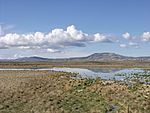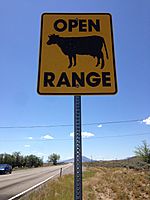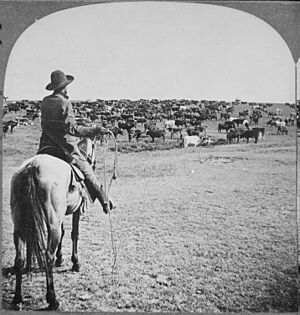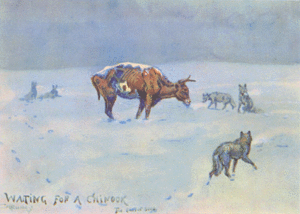Open range facts for kids
Open range is a term used in the Western United States and Canada. It describes areas of rangeland where cattle can wander freely. This happens even if the land belongs to different owners.
In places with "open range" laws, if you don't want animals on your property, you must build a fence to keep them out. This rule also applies to public roads. However, some open range areas can be changed into "herd districts." In a herd district, the animal's owner is responsible for keeping their animals fenced in. Most eastern states and parts of Canada require animal owners to fence in their livestock.
Contents
The History of Open Range
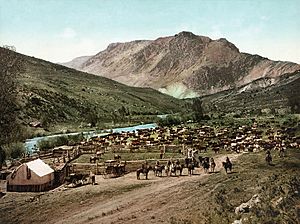
The idea of open range started when settlers moved into the new western territories of the United States and Canada. At first, there were no rules about where livestock could graze. Later, these practices became laws in many Western US states.
Over time, more people moved to the West. New things like railroads, mines, and farms appeared. Because of this, open range laws began to change and were used less often. But they still exist in some parts of most Western US states and Canadian provinces.
Open range practices also happened in other places. These include the Caribbean and some Eastern US states, like South Carolina long ago. It was also common in Mexico. Some people believe that the Mexican way of raising cattle might have influenced the open range practices in the American West. Many parts of the American West were once part of Mexico.
Why Open Range Started in the West
Unlike the Eastern United States, the Western prairies in the 1800s were huge and undeveloped. The land was also very dry, with water sources far apart. Before barbed wire was invented in the 1870s, it was easier to fence animals out of developed areas than to fence them in.
The United States government gained Western lands through purchases, wars, and treaties. Land that was not yet owned by private people was public. This public land was free for cattle to graze on.
Life on the Open Range
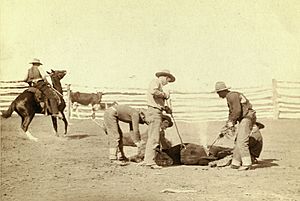
cowboys cared for the free-roaming cattle. They moved them between grazing lands and drove them to market. Brands on the cattle showed who owned them. Unbranded cattle were called "mavericks." Anyone who could catch and brand a maverick could claim it.
The End of the Open Range Era
The invention of barbed wire in the 1870s changed everything. It made it much easier to keep cattle in specific areas. This helped prevent overgrazing and was cheaper than hiring many cowboys.
In places like Texas, more people meant ranchers had to fence their own land. This caused some conflicts, sometimes called the Fence Cutting Wars. People would illegally fence off public land, blocking roads or other uses. In 1885, the U.S. government made it illegal to fence public land. By 1890, most illegal fences were gone.
In the northern plains, too many cattle grazing on the open range led to problems. There wasn't enough food for them in winter. The very cold winter of 1886–1887 killed hundreds of thousands of cattle. This caused the cattle industry to crash.
By the 1890s, barbed-wire fences were common. Railroads had spread across the U.S. Meatpacking plants were built closer to ranching areas. This meant long cattle drives from Texas to Kansas were no longer needed. The age of the open range was largely over.
Open Range Today
Today, in places with "open range" laws, people must build a "legal fence" to keep animals off their property. If livestock break through a proper fence, the owner of the animals might have to pay for damages. But if there is no legal fence, the animal owner is usually not responsible. However, owners are expected to control "unruly" animals like breeding bulls.
Most Western states now limit open range to specific areas. Free-roaming cattle can be a problem and a danger in developed places.
Cattle and Cars
On roads within an open range area, if a car hits a cow, the rancher was once not usually responsible. But since the 1980s, laws have changed. Ranchers now have more responsibility. They must keep cattle off federal highways and other busy roads. In some states, open range grazing is only allowed at certain times of the year.
In some states, like Montana, court decisions have almost ended the open range idea, even if old laws are still on the books. Today, you are more likely to hit a wild animal than livestock on the road.
Laws are still changing. In Arizona, livestock must be fenced in within cities. But in some areas outside cities, they are still just a "nuisance." Some people want to get rid of this old law. Ranchers often say that changing the law would make their work too hard.
In Idaho, which is an open-range state, livestock have the right of way on roads. If a vehicle hits and kills an animal, the driver might have to pay for the animal and for car repairs. However, Idaho counties can create "herd districts." In these districts, livestock owners must build fences to keep their animals off roads and neighbors' properties. In a herd district, the animal owner is responsible for any damage.
Images for kids


